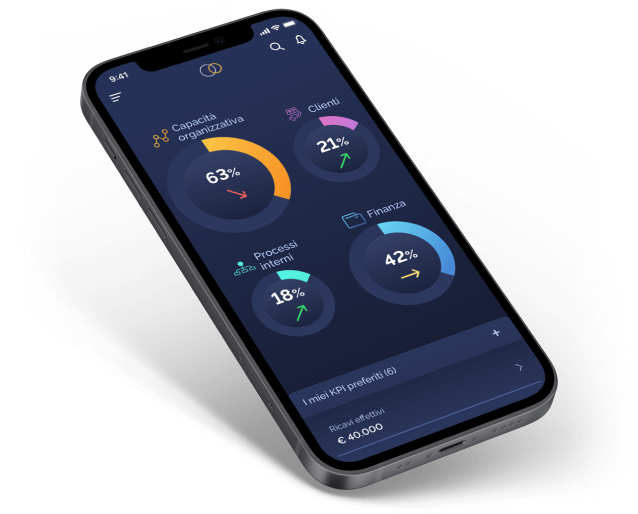
Clearly, the CEO’s rating comes from economic-financial and strategic results: profit, cash, and growth. But an application like Thauma, which aims to be a digital twin of the CEO and their company, should try to offer something more.
Thauma is “CEO-centered,” always starting from the CEO’s lived experience. Thauma is a resident of the world of CEOs of small and medium-sized enterprises, made up of workshops, forklifts, trucks, and flights on commercial airplanes.
CEOs who have maintained contact with products (admired and imitated) and manufacturing processes kept secret more by the skill of operators than by patents.
For this reason, Thauma knows what some of them would desire more: a 25-hour day!
Unfortunately, despite “thauma” deriving from “thaumaturge,” meaning one who performs wonders. Thauma doesn’t perform or promise wonders. Instead, it has a methodological proposal to allow the CEO to assess their work more objectively.
The Return on Management (RoM)
Robert Simons, a well-known management guru from Harvard, proposed an index for evaluating the CEO’s activity: the “Return on Management” or RoM.
Just as there are financial indicators that calculate the return on capital with a measure of “margin” in the numerator and “invested capital” in the denominator, Simons suggests using a measure of “result” (the productive energy released by the Organization) at the top of the fraction and a measure of “effort” (the time and attention invested by the CEO) at the bottom.
The formula is thus: RoM = Energy of the Organization / CEO Time Investment
This is a qualitative RoM. According to Simons, the CEO who maximizes RoM focuses on:
- Defining strategic boundaries within which the organization moves in pursuing business opportunities (minimum turnover, profitability, growth rate, competitive position).
- Critical performance measures driven by a healthy fear of failure, imbued with a sense of corporate responsibility.
- Performance measures always present as guiding criteria for work, not as formal systems (“paperwork”).
- Focus on truly essential processes (not on all processes).
- Ensuring that everyone looks where the leader looks.
So far, Simons. Thauma aims to take a few steps forward in two directions:
- Analyzing RoM more effectively from a qualitative perspective.
- Trying to transform it into a quantitative measure.
The RoM: Numerator, Denominator, and CEO’s Cognitive Skills
Taking a closer look at the indicator, starting with the numerator, we can derive some characteristics that well represent the CEO’s way of operating.
Being a CEO is not a job for the lazy. The CEO is usually a person abundantly endowed with vital energy but manages to release it to the organization they lead only if they have the time and the right concentration to do so.
The laws of thermodynamics also apply to the actions of top management. Effective CEOs have virtually unlimited energy, but a portion of this energy does not transform into the organization’s movement as it is “wasted,” converting into “unproductive heat” due to “friction.”
Friction in communication, power, resources, etc… the life of organizations is also, and in the worst cases predominantly, made up of friction. This is inevitable; it’s a general law. What depends on the individual CEO, however, is how much of their energy is converted into work and how much is wasted.
A CEO’s contribution to the organization’s performance is their “energy yield,” and each CEO has an individual “energy yield” different from others.
At the denominator of the indicator are the CEO’s two scarcest resources: time and attention. Clearly, this is not about time measured by the clock, where commitment is proportional to duration.
In the lives of CEOs, the inverse relationship often holds: the more time is spent, the less that time is well spent for significant results. The CEO’s time is marked by achievements, not by the clock’s hands. The main obstacle to its effective use (so much so that a profitable consulting and coaching industry on “time management” has emerged) is the ability to focus attention.
Everyone today lives in an era of informational and cognitive overload, with perceptual stimuli attacking attention and requiring defense. The CEO is exposed to the constant stress of processing information and making decisions. Not surprisingly, CEOs generally surround themselves with trusted individuals whom they ask to filter the continuous demands from all sides: suppliers, clients, employees, banks…
The best CEOs possess specific character traits and key cognitive skills; here, we are interested in the latter.
Among these, related to information management, stand out:
- The ability to grasp the big picture and synthesize (or holistic vision)
- The ability to make sense of events
These qualities can be amplified by good tools or diminished by organizational friction (including inadequate tools).
Clausewitz in 1832 identified “coup d’oeil” as one of the two essential qualities of a victorious general (for him, it was Napoleon, the other trait being determination). However, the “coup d’oeil,” in predisposed individuals, can be enormously amplified by technological tools. In fact, it’s the combined “coup d’oeil + tool” that often constitutes the condition for the CEO’s advancement in understanding.
Chester Barnard, CEO of Bell Telephone, said:
“There are many businessmen who can take a balance sheet of considerable complexity and in a few minutes or even seconds deduce from it a significant set of facts. These facts do not emerge from the paper, yet they strike the eye. They lie among the figures in the part that the mind completes with years of experience and technical knowledge. This is what extracts something from a set of numbers to which reason can be usefully applied.”
The power of a well-designed graphical interface in representing information for decisions is widely demonstrated. Similarly, it’s shown that a misleading representation leads to forming an incomplete or even incorrect informational picture.
Another source of a CEO’s competitive advantage is the ability to make sense of events (“connecting the dots”). It’s the skill of recognizing an underlying structure in a complex set of information that doesn’t speak for itself. There are different ways in which this skill can manifest.
- The CEO identifies a pattern in events or information that others don’t see and uses the pattern to interpret events or information:
“Why are we losing these clients (and not others)? Because they have always bought product X from us, which is in the declining phase of its life cycle.”
- The CEO identifies useful correlations and sees similarities between complex data from unrelated situations:
“What do all the growing clients have in common, and what about those that are declining? With product X, we solve their warehouse problem, which we don’t do with product Y.”
- The CEO identifies a key aspect of a complex situation:
“In the end, what are we not giving to the clients? They want an edge on the product, and we ask them to buy more instead.”
- The CEO uses clues to follow paths not taken by others, transforms partial and distorted information into valid information by purging it from “noise” and “distortions”:
“While we rest on our margins and live off our rent… we fail to realize that we are in a very precarious situation in the long run.”
The CEO reduces the mass of information bombarding them by using conceptualizations not used before; consolidates ideas, issues, and observations into a single concept or a clear presentation; is capable of rationalizing unpredictable and uncertain situations, intuiting the implications of ambiguous situations.
To do this, the structured information produced by highly technical accounting reporting systems can sometimes be of little help, if not an obstacle.
Thauma intentionally adopts very agile and non-specialized presentation formats to avoid creating friction in the CEO’s ability to release their energy to the organization.
And how can Thauma increase the value of RoM?
How/with what does it increase the Organizational Productive Energy Released by the CEO?
- Empowering the CEO with the information they need without asking anyone, when and how they need it, produces effectiveness and promptness in implementing corrective measures with their collaborators.
- Synthetic information (relevance and selectivity) increases the effectiveness of the CEO’s communication to the structure and their collaborators: sharing and dissemination within the organization.
- Reduction of the cost of accessing information.
How does it decrease the Time Invested and improve Attention?
- Reducing the time and cost of information sharing (less paperwork).
- Having the ability to access information anytime and anywhere, leveraging moments “freed” from routine.
Calculate the RoM with Thauma
Until now, RoM has been viewed purely qualitatively. But Thauma aims to attempt measuring it and expressing it in numbers.
A theoretical premise: according to some economists (Schumpeter, Rumelt), profit is the “reward for entrepreneurship” and can be configured as an “entrepreneurial rent” defined as “the difference between an ex-post value (or a cash flow) and the ex-ante cost (or value) of the resources invested to create the business.”
In a context devoid of uncertainty and thus entrepreneurial risk, the expected value (ex-post) equals the cost (ex-ante), suitably made comparable through the risk-free investment discount rate.
In a context characterized by risk, such as entrepreneurial activity, and therefore high ex-ante uncertainty, this equality is far from guaranteed. So, profit is the difference that a successful entrepreneurial activity generates between the cost of all employed factors of production and the incomes generated; this “extra-profit,” or “goodwill,” or “entrepreneurial rent,” is precisely the additional contribution brought by the “goodness” of the idea and entrepreneurial management.
Of course, in a well-functioning, competitive market, this rent is not “guaranteed” but must be continuously defended and renewed; otherwise, competition will quickly erase it. In Thauma’s language, profits go to those who decide the course and generally invest capital, while the extra profit would go to those steering the ship.
Adding another idea: the concept of “cake sharing.” The cake of the overall value produced is given by revenues. We pretend that revenues coincide with cash inflows, and in the long term, this is true. Revenues must then be divided into many parts among the factors of production (and a few other entities).
The factors of production easiest to identify are:
- Suppliers of goods and services (remunerated by purchasing costs)
- Capital providers in the form of interest (remunerated by interest)
So the Income Statement is:
REVENUE – PURCHASE – INTERESTS = GROSS ADDED VALUE 1st
GROSS ADDED VALUE 1st – AMORTIZATION = GROSS ADDED VALUE 2nd
Strictly speaking, the costs for services (for general expenses) should be applied to the distinction made for labor, but this is overlooked for simplicity.
The Gross Value Added 2nd must remunerate 4 categories of stakeholders:
- Workers
- Management
- Shareholders
- Tax authorities
The tax authorities are not a problem: taxes paid or the nominal rate can be deducted from the Gross Value Added 2nd to obtain Net Value Added.
Identifying the Management in the strict sense and its compensation is not a problem.
However, the costs of workers are separated into two categories:
- Operations (broadly speaking, those who produce or are essential for production)
- Management (broadly speaking, those who coordinate). It is clear that a clear line of separation cannot be drawn, e.g., the CFO insofar as he deals with interests with banks is operations, to the extent that he does the accounting is management… But a certain level of approximation is acceptable.
The separation priciple is based on:
Operations
- Does (executes)
- Orientation to doing things well
- Short-medium orientation
- Highly structured tasks
- Prevalence of operational flows as a decision-making criterion
Management
- Enables others to do – Coordinates – Organizes
- Orientation to identify the right things to do
- Medium-long orientation
- Less structured tasks
- Decisions restructure operational flows
So a production programmer is Operations, the Chief Operations Manager is Management, the CFO is Management, the accounts payable clerk is Operations, salespeople are Operations, the Chief Marketing & Sales is Management, and so on…
The second real problem if you wanted a job done by the book is identifying the remuneration destined for shareholders.
Here there are many methodologies… EVA, Economic Added Value©, RI, Residual Income, which uses the opportunity cost of capital…
In any case, the technical problems are the determination of the base, capital, which in the financial statements is very messy, and the rate, which should also include the beta coefficient or the specific risk rate of the sector (to be added to the rate for non-diversifiable risk).
These are “little problems” not to be underestimated if you want to be purists. If, on the other hand, simplifications are accepted, and Thauma often does, it can be decided that, conventionally, the remuneration of shareholders is:
SHAREHOLDER REM. = OWN CAPITAL * CONVENTIONAL REMUNERATION RATE
In summary:
GROSS ADDED VALUE 2nd – TAXES = NET ADDED VALUE
NET ADDED VALUE – LABOR COST OF OPERATIONS = MANAGEMENT ADDED VALUE
MANAGEMENT ADDED VALUE – LABOR COST OF MANAGEMENT – SHAREHOLDERS REM. =
= PROFIT / LOSS GENERATED BY MANAGEMENT WORK = RoM
There is a “profit” if the value added produced by the management activity is higher than its cost and allows adequate remuneration to shareholders, a loss otherwise.







